
What to Wear in Winter in Iceland
- How's the Weather in Iceland in Winter?
- November and December
- January and February
- March and April
- What to Wear in Iceland in Winter
- What to Wear in Reykjavik in Winter
- What to Wear for Winter Activities in Iceland
- Other Essentials to Pack for Iceland in Winter
- FAQs about What to Wear During Winter in Iceland
- Can I rent winter clothing in Iceland?
- Do my outer layers need to be waterproof?
- Do I need to bring special clothing for visiting restaurants and bars in Iceland?
- Should I pack an umbrella for winter in Iceland?
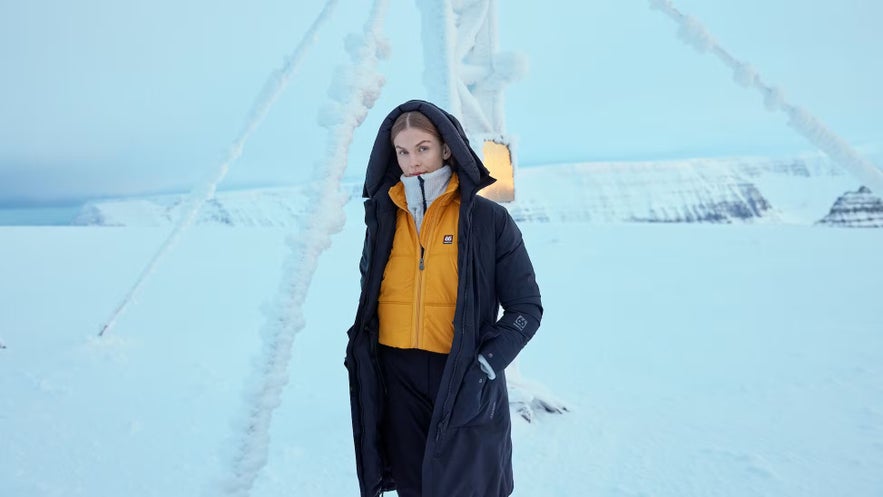
Preparing for a winter adventure in Iceland is exciting, and knowing what to wear is key for a comfortable and unforgettable journey. Whether you're opting for a city break and staying in cozy Reykjavik accommodation or embarking on self-drive tours around the country with a convenient rental car, the right preparation is essential.
While exploring the beautiful landscapes during winter tours, you'll notice how quickly the weather can shift from serene snowfall to blustery winds. This unpredictability isn't just a challenge; it's part of the Icelandic charm!
Your itinerary will likely be packed with diverse activities, from glacier hikes to northern lights tours, and whatever your plans, dressing appropriately is crucial. Embrace the breathtaking winter scenery in comfort by being well-equipped with suitable attire.
In this article, you will find links to some clothing from 66°North, Iceland's premier outerwear company, that we highly recommend. Customers of Guide to Iceland can enjoy a 20% discount off 66°North clothing by using the VIP Club.
Discover what to wear during an Icelandic winter, ensuring your experience is as magical and memorable as possible. Plan your adventure with this helpful guide!
- Learn all about Iceland in Winter - The Ultimate Travel Guide
How's the Weather in Iceland in Winter?
The winter in Iceland is generally said to last from November until early April, and unsurprisingly, weather and temperature can be quite different depending on which month you're visiting. Here's how they differ!
November and December
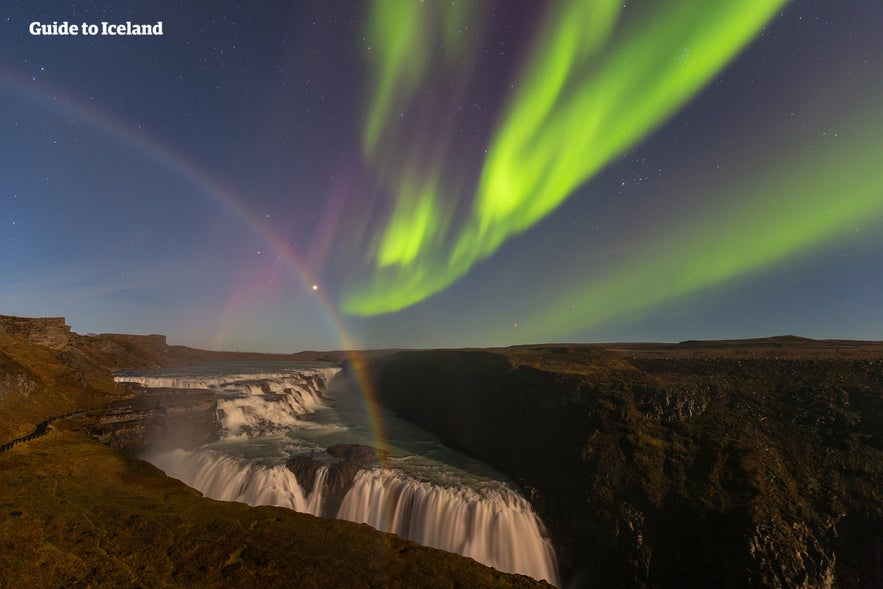
November and December mark the start of winter. The temperatures start to drop, hovering around 34°F (1°C), but don't be surprised by occasional dips below freezing. It's common to see snow dusting the landscapes, especially in the Eastfjords, Westfjords, and North Iceland.
Shorter days lead to longer nights, which means less daylight for exploring, but it also means that these months are the perfect time for northern lights hunting! The weather is still relatively mild, making it more comfortable to embark on northern lights tours or to navigate with your rental car.
- Learn more about Iceland in November and Iceland in December
- See also: Northern Lights in Iceland - When & Where To See the Aurora
January and February
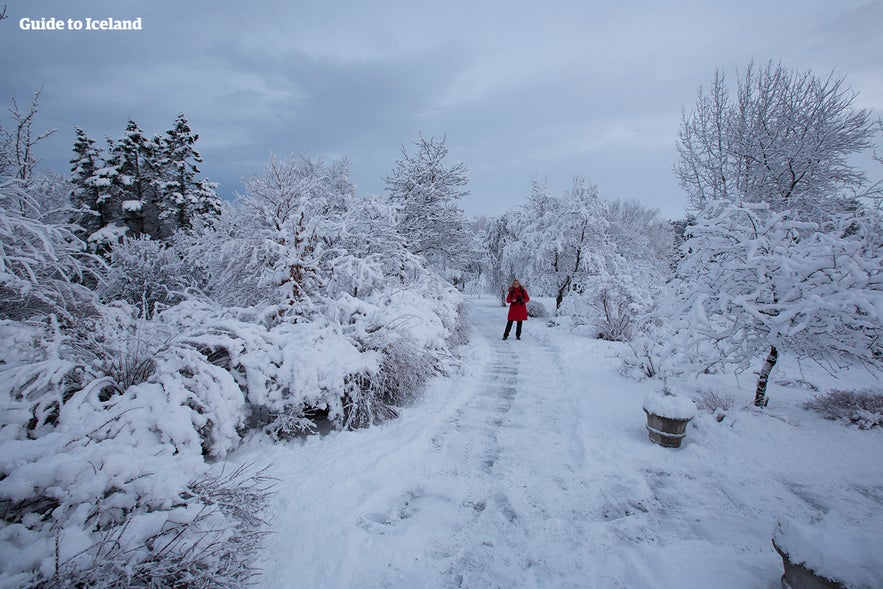 January and February are the heart of Icelandic winter. These months are characterized by their chillier temperatures, often dropping all the way to 14°F (-10°C) and, in some cases, even further! Snowfall is more consistent, draping the stunning landscapes in a blanket of white.
January and February are the heart of Icelandic winter. These months are characterized by their chillier temperatures, often dropping all the way to 14°F (-10°C) and, in some cases, even further! Snowfall is more consistent, draping the stunning landscapes in a blanket of white.
It's essential to be prepared for sudden changes in weather, as clear skies can quickly turn into snowstorms. Despite the cold, the beauty of the frozen landscapes is unmatched, and the longer nights continue to offer spectacular opportunities for aurora sightings. Just make sure to choose the best size of car for this time of year, as heavy snow and ice is best tackled with a 4x4 rental vehicle.
- See also: Iceland in January and Iceland in February
March and April
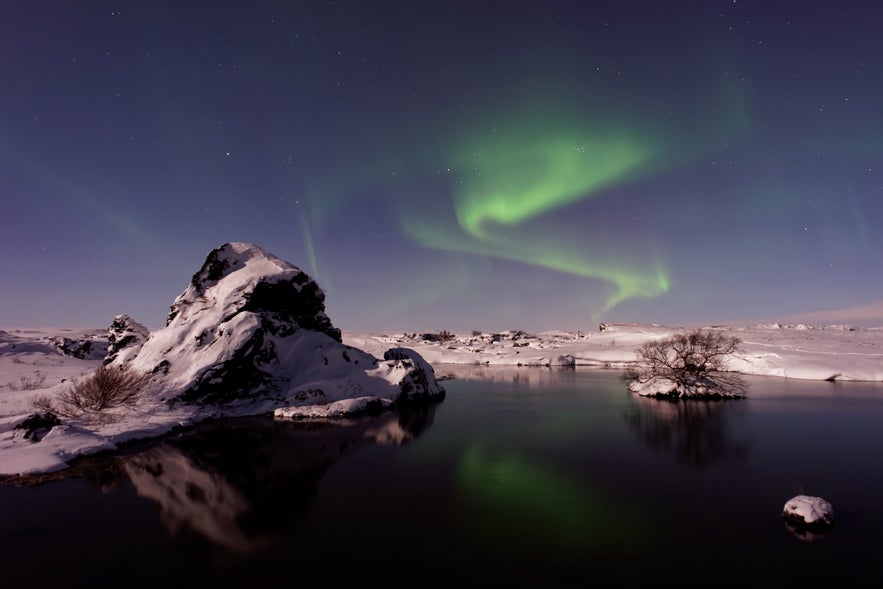 As Iceland bids farewell to winter, March and April bring about a time of transition. The temperatures start to climb, averaging around 0°C-5°C (32°F-41°F). Snow begins to thaw, revealing the first signs of spring. You'll experience longer daylight hours, giving you more time to explore. The weather can still be unpredictable, with a mix of very strong winds, snow, rain, and, occasionally, glimpses of early spring sunshine.
As Iceland bids farewell to winter, March and April bring about a time of transition. The temperatures start to climb, averaging around 0°C-5°C (32°F-41°F). Snow begins to thaw, revealing the first signs of spring. You'll experience longer daylight hours, giving you more time to explore. The weather can still be unpredictable, with a mix of very strong winds, snow, rain, and, occasionally, glimpses of early spring sunshine.
- Discover Iceland in March and Iceland in April
What to Wear in Iceland in Winter
Venturing to Iceland during the winter requires thoughtful preparation in terms of attire. It all depends on your itinerary, but in general, the key to warmth and comfort is layering!
Start with a moisture-wicking base layer to keep dry, such as a soft Polartec top (Grettir). Add a warm middle layer like a fleece zip-neck (Hrannar) or wool sweater for insulation, and top it off with a waterproof and windproof outer layer. It's also recommended to choose outer clothing that has light-reflective properties so you're visible in the darkness.
Sturdy, waterproof boots are a must for navigating snowy and icy terrain. Investing in good crampons is also a good idea, as falling on sneaky ice can easily cause an injury!
Accessories are also very important. Make sure to bring a good quality hat, gloves, and a scarf to protect against the biting cold and winds. Thick thermal socks can also be a lifesaver when walking outside, as your toes will go numb very quickly.
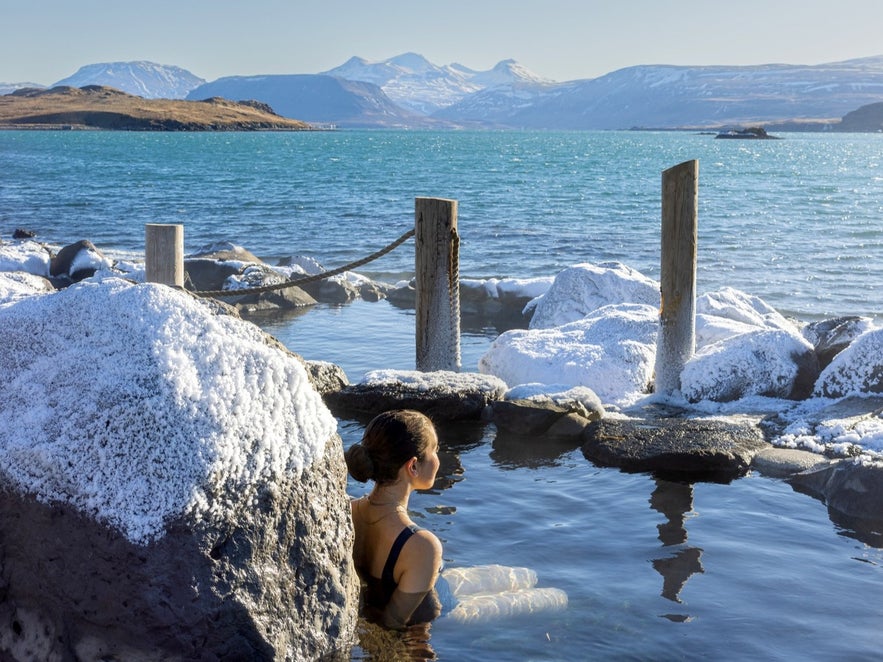
Photo from the Hvammsvik Hot Springs
Of course, one of the most important things to bring is swimwear, though this is true for any time of year. You won't want to miss out on hot spring tours and experience Iceland's famous bathing culture! Plan a visit to locations like the Blue Lagoon, the Sky Lagoon, or Hvammsvik Hot Springs, as there are few things as delightful as soaking in the warm water with the fresh cold wind on your face.
Other easy things to forget about are sunglasses and sunscreen, which are also essential. The snow can be very reflective, which can be dangerous if you're driving. Also, remember to bring moisturizer, hand cream, and a good lip balm. The cold is very rough on the skin!
- See also: What to Wear in Iceland: The Ultimate Guide for All Seasons
- Also, check out What To Pack for Iceland for All Seasons
What to Wear in Reykjavik in Winter
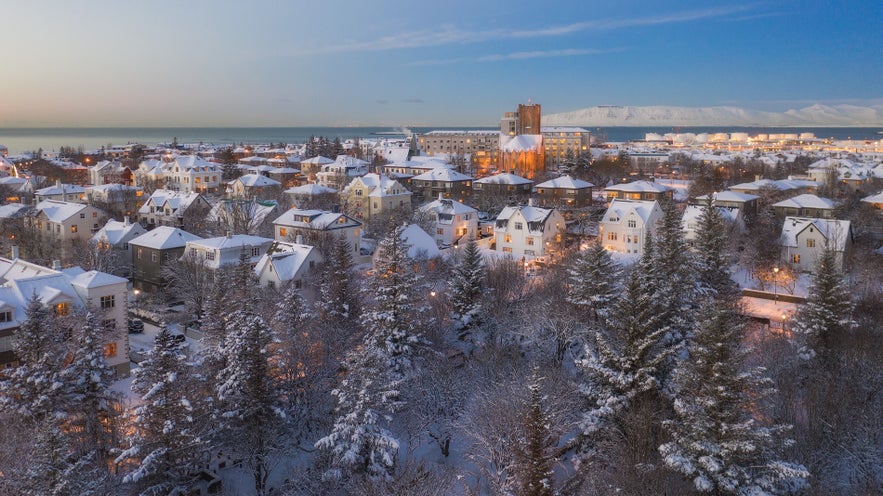 The winter weather of the South Coast and the Capital Region tends to be milder than the rest of the country. There's still a risk of high winds and snow, but generally speaking, you can get away with slightly lighter clothing than when exploring the countryside.
The winter weather of the South Coast and the Capital Region tends to be milder than the rest of the country. There's still a risk of high winds and snow, but generally speaking, you can get away with slightly lighter clothing than when exploring the countryside.
One factor to consider is that you'll likely be moving in and out of buildings and visiting museums, shops, restaurants, and other cultural attractions. This is why it's especially important to have easy-to-remove layers in Reykjavik.
Consider going for a long waterproof down jacket (Drangajökull) or a comfortable puff coat (Dyngja) with light wool or thermal sweater under. You can also choose smaller boots, but bring those crampons! If you're visiting in November or April when winter isn't at its most dramatic, you can also go for more regular clothing and simply wear a Merino wool top (Básar) and pants layer (Básar) under loose jeans, ankle boots, or a cotton sweater. This will, however, depend entirely on how much time you'll be spending outside!
- Learn more: The History of 66°North: Keeping Iceland Warm for a Century
- See also: The Ultimate Winter Itinerary for Iceland
What to Wear for Winter Activities in Iceland
If you're planning a winter trip to Iceland, many adventures are waiting! Whether it's seeing the majestic northern lights, exploring ice caves, or flying over snowy fields on a dog sled, it's important to be well prepared. Here's what to wear to some of the best winter activities in Iceland!
Glacier Experiences in Iceland:
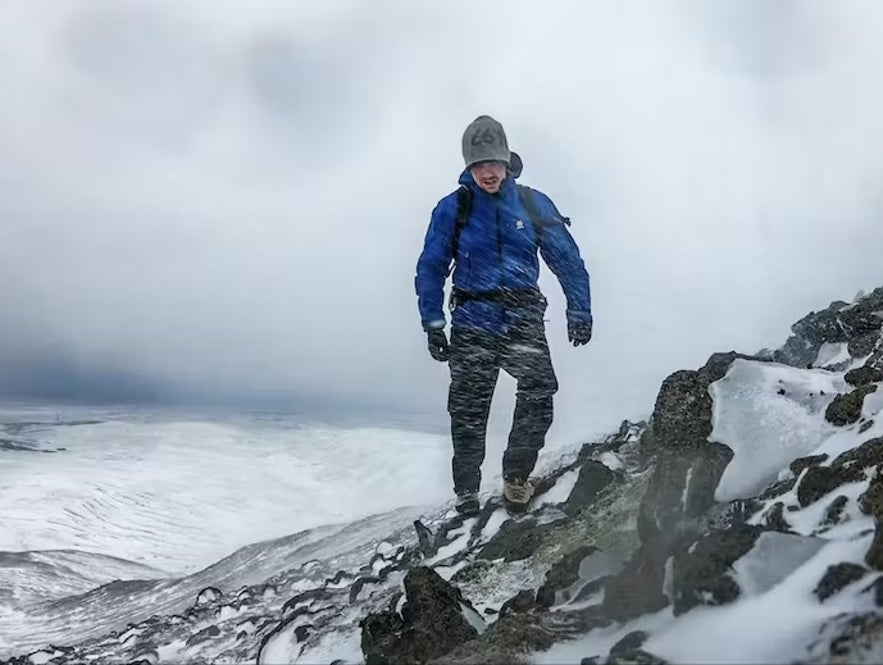 Iceland has some stunning glaciers, including the majestic Vatnajokull, the largest glacier in Europe! They offer many chances for adventures, such as glacier hikes, ice-caving tours, and snowmobiling over the icy planes that are sure to provide some long-lasting winter memories.
Iceland has some stunning glaciers, including the majestic Vatnajokull, the largest glacier in Europe! They offer many chances for adventures, such as glacier hikes, ice-caving tours, and snowmobiling over the icy planes that are sure to provide some long-lasting winter memories.
However, as winter in Iceland tends to already be quite cold, you can expect the frosty glaciers to be even colder, so there are some things to keep in mind when packing for your glacier adventure.
If you're visiting an ice cave, such as with this popular tour in Vatnajokull glacier from the Jokulsarlon glacier lagoon, the focus should be on good layers. If you've invested in a warm quality base and mid-layers for your winter trip to Iceland, you'll mostly need to complete the outfit with a waterproof and windproof jacket and shell pants. Depending on the warmth of your layers, and any other activities on your trip, you can either go for a warm down jacket (Tindur) or a quality waterproof shell jacket (Snæfell).
You'll need good hiking boots and crampons, which are sometimes provided by your chosen tour operator, and remember to bring water-resistant gloves and thermal socks.
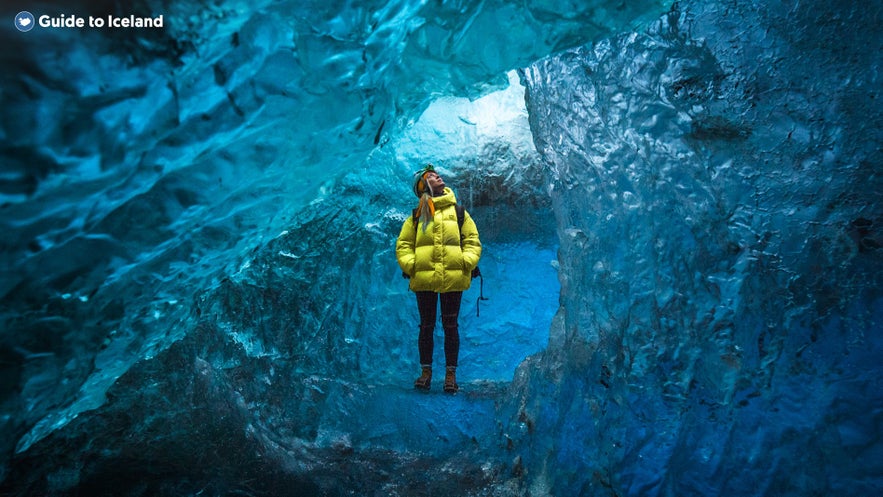
Photo from Best Ice Cave Tour in Vatnajokull Glacier Starting from Jokulsarlon Glacier Lagoon
In general, you can follow the same guidelines when going glacier hiking or snowmobiling, as it's a very similar environment, but you'll want to place more emphasis on protecting against wind chill. You won't have the benefit of the cave walls for shelter!
Also, consider bringing sunglasses or other protective eyewear as the sun's glare from the light reflecting off the ice can be strong! We also recommend applying sunscreen before embarking on your glacier adventure.
- Plan your ice cave visit: What to Wear for Ice Caving in Iceland
- Learn more: What to Wear for Glacier Hikes in Iceland
- Also, check out Snowmobiling in Iceland: An Essential Guide
Northern Lights Tours in Iceland:
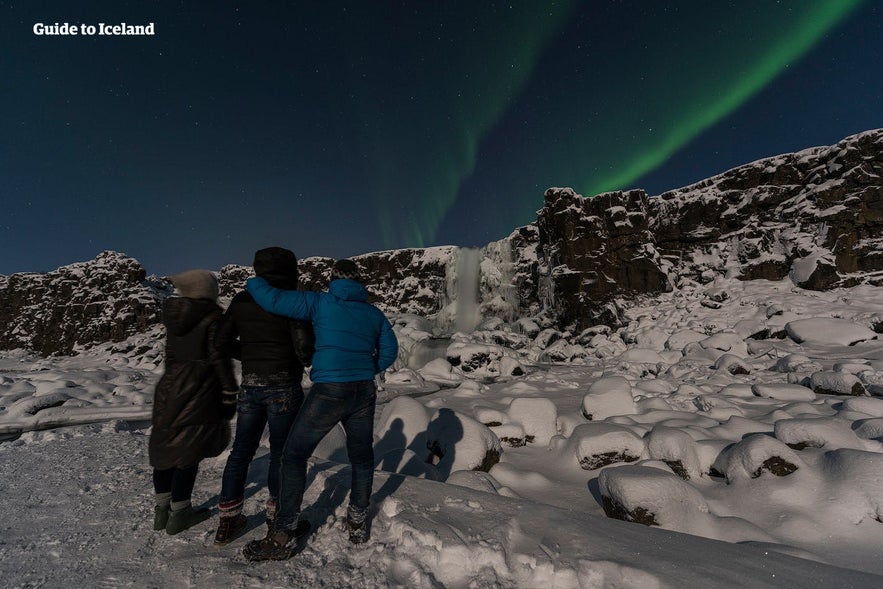
One of the most magical aspects of the Icelandic winter is the chance to see the northern lights dancing in the night sky. However, as the lights show up whenever and wherever they please, observing them can require quite a bit of time, standing around patiently and waiting for them in the cold winter air.
This is why it's so important to prepare appropriately when going on northern lights tours or when hunting for them yourself with your affordable rental car. You'll automatically keep yourself warmer when you're on the move, but when you're standing around observing the sky, it's immensely important to dress warmly.
Along with the usual base and mid-layers, choose an even warmer coat or add more sweaters under your regular jacket. A warm hat is very important, and you may even want to go for a wool balaclava (Bylur) to fully protect yourself from the cold, as you lose most of your body heat from your head! Don't forget good wind-proof gloves (Langjökull) and wool or thermal socks as well.
You'll also want to keep blankets with you if you're planning to stay out for extended periods of time. If you have the possibility, we highly recommend bringing hot coffee, chocolate, or tea in a thermos to help warm you up from the inside out, which will also add to the adventure! Remember to take breaks from the cold night air and return to your tour bus or rental car to warm back up.
- Learn more about the Northern Lights in Iceland - When & Where To See the Aurora
Dog Sledding in Iceland:

Photo from Incredible 2-Hour Siberian Husky Dog Sled Sightseeing Tour by the Myvatn Area
The most adorable way to enjoy the snowy winter is, without a doubt, by going dog-sledding in Iceland. Sweeping across the snowy planes in the company of fluffy dogs is truly something any animal lover must experience when visiting Iceland in winter!
You'll want to prioritize a warm base and mid-layers, good gloves, and a warm hat. Many tour operators offer overalls to protect from the cold and keep your clothes clean, but double-check with them beforehand. If not provided, bring a warm, waterproof jacket and shell pants, preferably ones that can be easily cleaned.
Don't forget sunglasses or ski goggles to shield your eyes from sun glare and debris stirred up by the dogs!
- Learn all about Dog Sledding in Iceland
Other Essentials to Pack for Iceland in Winter
 Besides clothing, there are several other essential items and accessories you should consider packing for your Icelandic winter adventure. A durable, waterproof backpack or bag is a must for carrying your belongings while keeping them dry and safe, especially when visiting ice caves. If you want to capture the northern lights and the beautiful nature, don’t forget your camera, along with protective equipment, extra batteries, and memory cards, as the cold can drain battery life quickly.
Besides clothing, there are several other essential items and accessories you should consider packing for your Icelandic winter adventure. A durable, waterproof backpack or bag is a must for carrying your belongings while keeping them dry and safe, especially when visiting ice caves. If you want to capture the northern lights and the beautiful nature, don’t forget your camera, along with protective equipment, extra batteries, and memory cards, as the cold can drain battery life quickly.
A portable power bank is also a wise addition, ensuring your phone stays charged during long outings. Investing in water-resistant covers for your electronic devices can save them from snow or rain. To stay hydrated and for added comfort, carry a thermos for hot beverages and a water bottle! Hot coffee, tea, or chocolate is the perfect companion for the Icelandic scenery and warms you from the inside out.
If you're planning to travel to more remote areas, consider bringing navigation tools, like a GPS device or updated maps, as cell service can be spotty. For the most remote locations, bring a first aid kit, including basic medications, plasters, and blister pads, which are all crucial for handling minor injuries on the go. These items, combined with the right clothing, will equip you for a safe and enjoyable Icelandic winter experience.
FAQs about What to Wear During Winter in Iceland
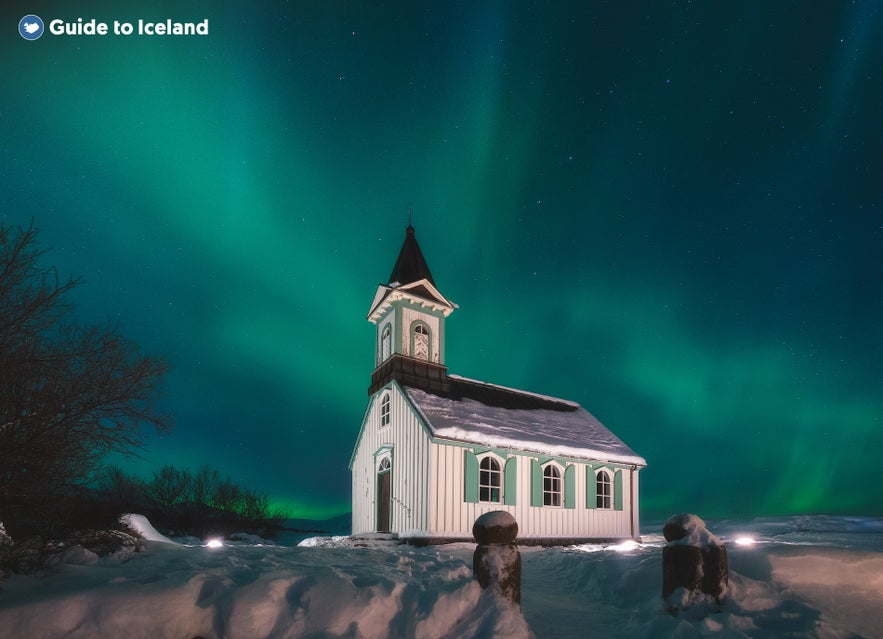
Here are some of the most asked questions about the Icelandic winter and what's best to wear!
Can I rent winter clothing in Iceland?
Yes, if you don't have suitable winter clothing or prefer not to waste luggage space to bring it with you, you can rent outdoor gear on Iceland's largest travel marketplace! You can find quality hiking boots, crampons, jackets, waterproof pants, and much more! It's advisable to book in advance, especially during peak tourist season, to ensure availability.
Do my outer layers need to be waterproof?
It is highly recommended that you have a waterproof jacket in Iceland, and preferably, waterproof over pants as well. Clothing that is advertised as windproof but not waterproof is not going to keep the wind out properly. If it keeps out water, it will keep out the wind!
Also, you'll want the proper water protection for outdoor activities like hiking, snowmobiling, or glacier hiking, especially as you'll likely be sitting on snowy surfaces.
Do I need to bring special clothing for visiting restaurants and bars in Iceland?
For evenings, especially in Reykjavik, casual to smart-casual wear is the norm. There's no need for formal clothes; a stylish sweater or shirt with pants and comfy shoes works great. Don't worry about dressing up too much unless you prefer it, as most restaurants don't have a strict dress code. If you don't want to bother with bringing the extra clothes, feel free to dine in your winter gear, as long as you don't mind standing out from the local crowd. Nobody will mind!
Should I pack an umbrella for winter in Iceland?
An umbrella is not very practical due to the strong Icelandic wind. A waterproof jacket with a hood is a much better option- or even a rain poncho!
- Discover Iceland's Seasonal Contrasts
- See also: Most Unique Experiences in Iceland
Preparing properly for Iceland's winter conditions can make your trip much more safe, enjoyable, and comfortable. Remember, the key is to be ready for the cold and ever-changing weather to make the most of your winter visit to Iceland!
What would you do during a winter trip to Iceland? Which month would you choose for your visit? Have you been to Iceland before? Please share your thoughts and experiences with us in the comment section below!
Other interesting articles

Top 5 Destinations in Iceland
What are the must-see places to visit on every journey to Iceland? See our list of the top 5 destinations in Iceland, find out where to go and how to get there! Find out What to Do & Where to...Read more
Earthquakes in Iceland: The Ultimate Guide
Discover all you need to know about earthquakes in Iceland. Learn about what causes earthquakes, their magnitude and frequency, and how they've shaped the country's landscapes and history. Dive into...Read more
SIM Cards in Iceland: The Ultimate Guide
Looking for the best way to stay connected during your Iceland adventure? Discover everything you need to know about getting a SIM card or eSim in Iceland. Whether you're visiting Reykjavik or expl...Read more

Download Iceland’s biggest travel marketplace to your phone to manage your entire trip in one place
Scan this QR code with your phone camera and press the link that appears to add Iceland’s biggest travel marketplace into your pocket. Enter your phone number or email address to receive an SMS or email with the download link.





















